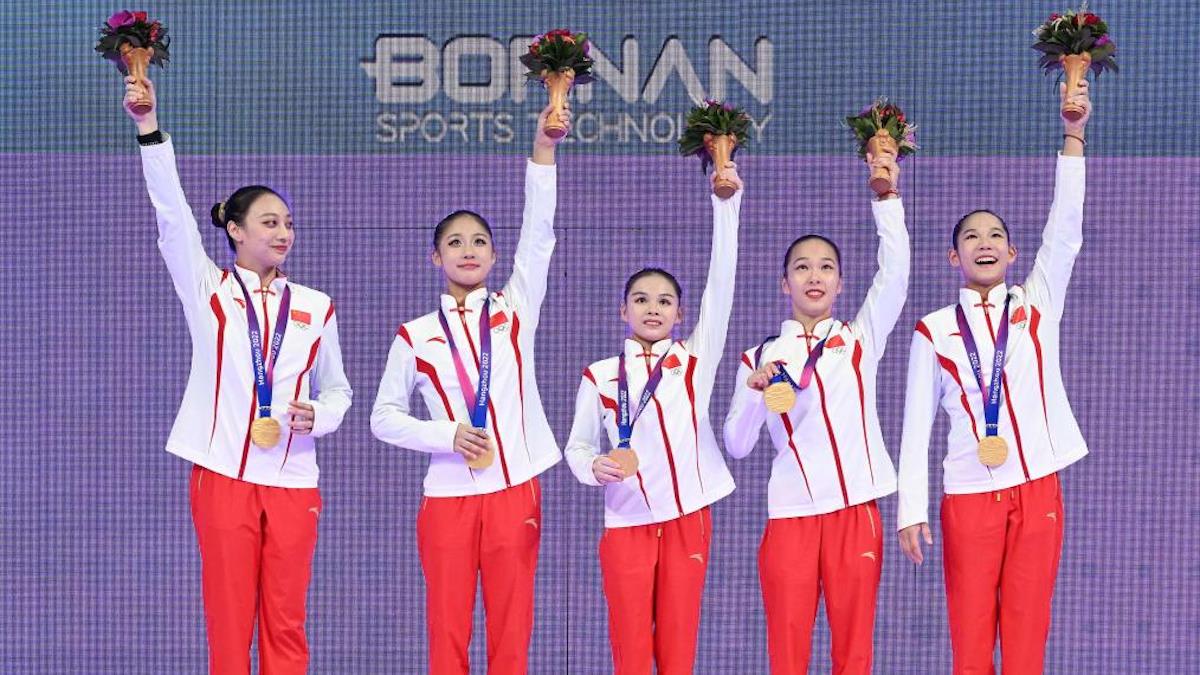
Team China
The Chinese women followed in the men’s footsteps at the Asian Games in Hangzhou, winning a gold medal by a decisive margin ahead of a strong Japanese B team, but the big surprise was the North Korean women – unseen in international competition since 2019 – taking the bronze.
It was an odd team that was selected to compete in Hangzhou, with the country’s top three all-arounders at nationals sent to world championships, though the worlds team isn’t as balanced as it could be, with almost no attention paid to vault. Instead, it seemed all of the vaulters were going to the Asian Games, and the team made some great headway there to get more than a point ahead of the rest of the field, in addition to performing well on bars and floor.
Zhang Jin brought back her tsuk double full to score a 13.9, and continued with the strongest overall performance both for the team and within the context of the entire competition to lead the all-around standings with a 54.266, while also earning spots in the beam and floor finals. Zuo Tong was next in line with a 52.865, doing her best work on bars to make the final with a 13.933, while Zhang Xinyi finished third with a 52.499 with a miss on beam, though she looked good elsewhere, and made the floor final with a 13.2.
The team’s strongest vaulter, Yu Linmin, put up a strong tsuk double of her own to earn a 14.033, and though her second vault was downgraded in qualifications, she still qualified in fourth place into the final with a 13.383 average. Finally, Tang Xijing complemented Yu by filling in on the other three events, and she thankfully looked much stronger on bars than she did at nationals, earning a 14.466 to lead qualifications while also making the beam final despite mistakes there.
Overall, it was a pretty great day for China, beam aside (hilariously, beam ended up being China’s lowest-scoring event due to the number of mistakes and falls), and they ended up with a 161.896, just about a tenth shy of what the team earned in qualifications at worlds last year. It’ll be interesting to see how the worlds team compares, as on paper they’re overall a bit stronger, but I think without any core vaulters, it could hold them back a bit, so I’m really excited to see how they compare to the team here.
While China’s worlds and Asian Games teams are somewhat evenly split in a way, Japan sent a clear “A” team to worlds, but a still talented and very capable “B” team to the Asian Games, and it was no surprise to see them walk away with a 157.229 to take the silver medal, and without would-be team leader Sakaguchi Ayaka, who traveled to world championships as the alternate.
Without Sakaguchi in the roster, only four gymnasts competed with all four taking on all-around duties. Okamura Mana, the strongest overall national competitor on this team after finishing seventh at the NHK Trophy, ended up the top qualifier for the team, earning a 52.432 all-around score with a fairly balanced performance. She’s typically a stronger beam worker, though still managed a 13.366 there to qualify third into the final, and she also made the bars and floor finals, showing just how much she was able to contribute to the team.
The rest of the team all finished in the top 11, with Ushioku Kohane eighth with a 52.165, Masui Misaki ninth with a 51.199, and Serita Mikako 11th with a 49.565 after struggling on floor, though she had an excellent bars set and qualified fifth into the final with a 13.533. Ushioku had an incredible day on her two standout events, making the vault final in third place with a 13.449 average and showing super strong landings on floor to qualify first with a 13.266, while Masui, who is brand-new to international competition, was at her best on beam, earning a 13.266 to make that final.
While Japan did some incredible work with a group of gymnasts who typically aren’t first-choice athletes for international assignments, there ended up being an unexpected fight for that silver medal as the North Korean team showed up to an international competition for the first time in four years and nearly got the upset, scoring just four tenths lower than the Japanese woman with a 156.829.
The team’s best gymnast four years ago, Olympic qualifier Kim Su Jong, remains the country’s best, putting up a stellar performance to earn a 52.365 in the all-around. Back in 2019, she was notable as a first-year senior for having one of the most artistic floor routines North Korea has ever produced, and her artistic qualities have grown with her, with her floor routine one of the most enjoyable of the competition. She earned a spot in that final in addition to the bars and beam finals, and it would be great to see her walk away with a little medal haul.
Her two all-around teammates finished directly behind her, with An Chang Ok placing sixth with a 52.265 while Kim Son Hyang was seventh with a 52.199. An was excellent on bars, earning a 13.933 to qualify third into the final, and she competed a Cheng on vault, helping her qualify first into the final with a 13.833 average. Kim also made the vault final with a Yurchenko double full and a handspring rudi, qualifying in second with a 13.583, and she also had solid work on bema and floor to reach both of those finals as well.
These three gymnasts were all standouts back in 2019, but the team here also featured two newcomers, including Sim Hae Won, whose only international experience was the Junior Asian Championships in 2017 where she won a bronze medal on bars, and Ryu Mi Rae, who made her international debut in Hangzhou. Sim showed a high level of difficulty on bars at a 5.9, though unfortunately had a fall there and missed the final, while Ryu competed only on vault, scoring an 11.666.
No other teams came close to a podium spot, with the remaining rankings seeing Taiwan in fourth with a 147.096, South Korea in fifth with a 144.196, Kazakhstan in sixth with a 142.829, Singapore in seventh with a 140.096, and Thailand in eighth with a 123.994.
Four of the six members of Taiwan’s worlds team competed here, including Ting Hua-Tien, who was the country’s best all-arounder in 10th place with a 50.665 while leading the beam qualification rankings with a 13.866, showing brilliantly fluid connections and artistry in her routine, and Lai Pin-Ju, who reached the all-around final with a 48.398.
South Korea sent a complete “A” team to worlds, and with veteran Lee Eunju ending up not able to compete, it meant the team’s overall strength was much lower than what we can normally expect from them, though we did see a couple of standout routines, including a 13.033 on floor from Lim Sumin, qualifying her into the floor final, while Yun Boeun made the bars final with a 12.066.
Aida Bauyrzhanova of Kazakhstan, who is set to compete in the all-around at worlds, had a strong qualifications performance to reach the all-around final with a 48.665 and the bars final with a 12.0, while fellow worlds qualifier Nadine Joy Nathan was Singapore’s best, finishing 15th in the all-around with a 47.466 and making the beam final with a 12.6, though she’s actually already off to worlds and will miss the final, with her spot going to teammate Kaitlyn Lim, the first reserve.
Of course, we have to talk about Oksana Chusovitina of Uzbekistan, who chose to compete here instead of at worlds. She competed only on vault here, and I imagine will make that her sole focus leading up to the world cup Olympic qualification series after missing out on qualifying an all-around spot to worlds this year, and she reached the final in fifth place with a 12.949 average. She performed at a lower level of difficulty than the athletes who outranked her, but she’s absolutely capable of upgrading in the final, and now that she knows what her competition’s looking like, I wouldn’t be surprised to see the upgrades – and a medal – coming on Thursday.
Also competing in the vault final are Pranati Nayak of India, Charlie Manzano of the Philippines, and Darya Yassinskaya of Kazakhstan, who also reached the floor final with a 13.0. Yassinskaya is qualified as a specialist to worlds on both of these events, and will have a tight turnaround with the floor final on Friday, but making these two finals here was a massive deal so I’m sure it’ll be worth the exhaustion in the end!
Please see below for a full list of the team rankings, as well as the qualifiers into each individual final.
Team Final Standings
1. China 161.896
2. Japan 157.229
3. North Korea 156.829
4. Taiwan 147.096
5. South Korea 144.196
6. Kazakhstan 142.829
7. Singapore 140.096
8. Thailand 123.994
All-Around Qualifiers
1. Zhang Jin, China, 54.266
2. Zuo Tong, China, 52.865
4. Okamura Mana, Japan, 52.432
5. Kim Su Jong, North Korea, 52.365
6. An Chang Ok, North Korea, 52.265
8. Ushioku Kohane, Japan, 52.165
10. Ting Hua-Tien, Taiwan, 50.665
12. Aida Bauyrzhanova, Kazakhstan, 48.665
13. Lai Pin-Ju, Taiwan, 48.398
15. Nadine Joy Nathan, Singapore, 47.466
16. Lim Sumin, South Korea, 47.432
17. An Yeonjeong, South Korea, 47.399
18. Kaitlyn Lim, Singapore, 46.531
21. Amina Khalimarden, Kazakhstan, 44.499
22. Sasiwimon Mueangphuan, Thailand, 44.264
23. Pranati Nayak, India, 44.232
25. Kursten Lopez, Philippines, 43.565
26. Ananya Patanakul, Thailand, 42.331
Vault Qualifiers
1. An Chang Ok, North Korea, 13.833
2. Kim Son Hyang, North Korea, 13.583
3. Ushioku Kohane, Japan, 13.449
4. Yu Linmin, China, 13.383
5. Oksana Chusovitina, Uzbekistan, 12.949
6. Pranati Nayak, India, 12.716
7. Darya Yassinskaya, Kazakhstan, 12.633
8. Charlie Manzano, Philippines, 12.583
R1. Wu Sing-Fen, Taiwan, 12.550
R2. Aida Bauyrzhanova, Kazakhstan, 12.499
R3. Nadine Joy Nathan, Singapore, 12.483
Uneven Bars Qualifiers
1. Tang Xijing, China, 14.466
2. Zuo Tong, China, 13.933
3. An Chang Ok, North Korea, 13.933
5. Serita Mikako, Japan, 13.533
7. Kim Su Jong, North Korea, 13.433
8. Okamura Mana, Japan, 12.933
12. Yun Boeun, South Korea, 12.066
13. Aida Bauyrzhanova, Kazakhstan, 12.000
R1. Nadine Joy Nathan, Singapore, 11.733
R2. Lai Pin-Ju, Taiwan, 11.566
R3. Ting Hua-Tien, Taiwan, 11.566
Balance Beam Qualifiers
1. Ting Hua-Tien, Taiwan, 13.866
2. Zhang Jin, China, 13.600
3. Okamura Mana, Japan, 13.366
4. Masui Misaki, Japan, 13.266
5. Kim Su Jong, North Korea, 13.166
6. Kim Son Hyang, North Korea, 13.100
7. Tang Xijing, China, 12.833
9. Nadine Joy Nathan, Singapore, 12.600
R1. Kaitlyn Lim, Singapore, 12.466
R2. An Yeonjeong, South Korea, 12.200
R3. Darya Yassinskaya, Kazakhstan, 12.166
Floor Exercise Qualifiers
1. Ushioku Kohane, Japan, 13.266
2. Zhang Jin, China, 13.233
3. Zhang Xinyi, China, 13.200
5. Okamura Mana, Japan, 13.133
6. Kim Su Jong, North Korea, 13.100
7. Lim Sumin, South Korea, 13.033
8. Darya Yassinskaya, Kazakhstan, 13.000
10. Kim Son Hyang, North Korea, 12.933
R1. Ting Hua-Tien, Taiwan, 12.500
R2. Sasiwimon Mueangphuan, Thailand, 12.466
R3. An Yeonjeong, South Korea, 12.400
Article by Lauren Hopkins
-----------------------
By: Lauren
Title: China Dominates, North Korea BACK in Women’s Competition at Asian Games
Sourced From: thegymter.net/2023/09/26/china-dominates-north-korea-back-in-womens-competition-at-asian-games/
Published Date: Tue, 26 Sep 2023 18:53:40 +0000
Did you miss our previous article...
https://ballerawards.news/sports/nfl-mvp-odds-tua-tagovailoa-is-now-the-outright-leader-over-patrick-mahomes






